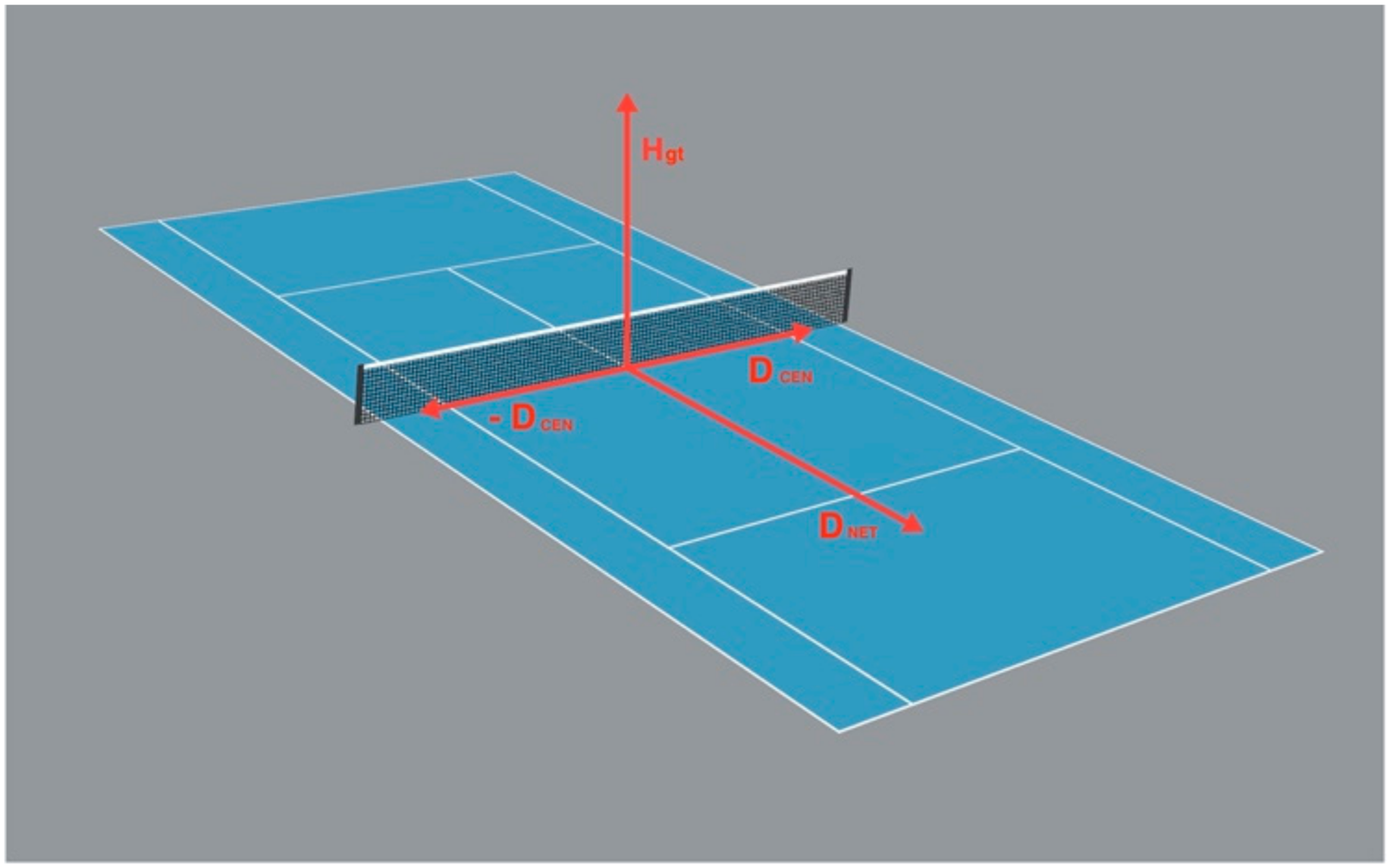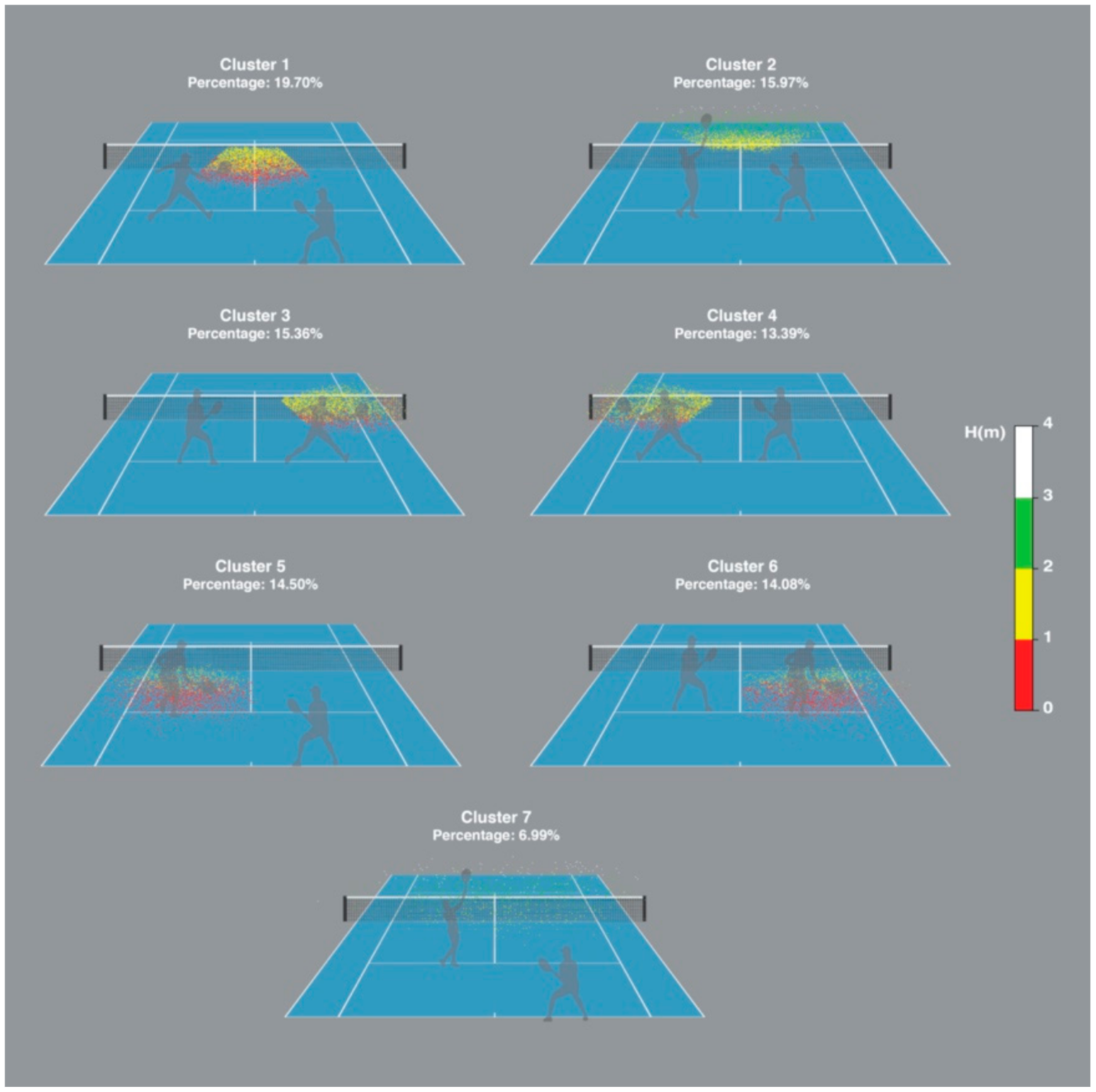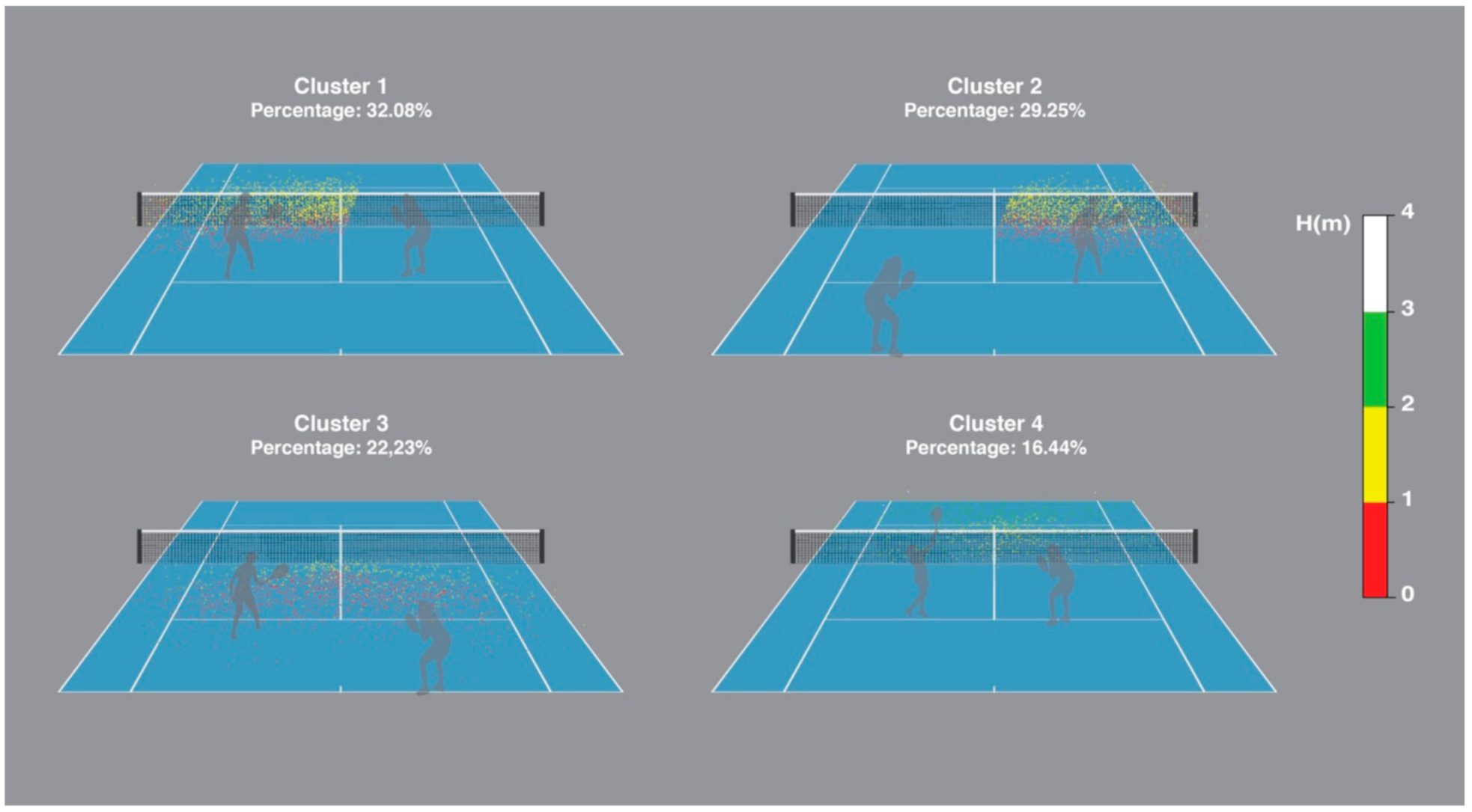A Cluster Analysis Approach to Profile Men and Women’s Volley Positions in Professional Tennis Matches (Doubles)
Abstract
1. Introduction
2. Materials and Methods
2.1. Sample
2.2. Data Analysis
2.3. Statistical Analysis
3. Results
3.1. Davis Cup
3.2. Billie Jean King Cup
4. Discussion
4.1. Davis Cup
4.2. Billie Jean King Cup
4.3. Limitations of the Study
5. Conclusions
Author Contributions
Funding
Acknowledgments
Conflicts of Interest
References
- Zhang, S.; Lorenzo, A.; Gómez, M.A.; Mateus, N.; Gonçalves, B.; Sampaio, J. Clustering performances in the NBA according to players’ anthropometric attributes and playing experience. J. Sports Sci. 2018, 36, 2511–2520. [Google Scholar] [CrossRef]
- Cui, Y.; Gómez, M.Á.; Gonçalves, B.; Sampaio, J. Clustering tennis players’ anthropometric and individual features helps to reveal performance fingerprints. Eur. J. Sport Sci. 2019, 19, 1032–1044. [Google Scholar] [CrossRef] [PubMed]
- Martínez-Gallego, R.; Vives, F.; Guzmán, J.F.; Ramón-Llin, J.; Crespo, M. Time structure in men’s professional doubles tennis: Does team experience allow finishing the points faster? Int. J. Perf. Anal. Sport 2021, 1–10. [Google Scholar] [CrossRef]
- Kočíb, T.; Carboch, J.; Cabela, M.; Kresta, J. Tactics in tennis doubles: Analysis of the formations used by the serving and receiving teams. Int. J. Phys. Educ. Fit. Sports 2020, 9, 45–50. [Google Scholar] [CrossRef]
- Crespo, M.; Miley, D. Advanced Coaches Manual; International Tennis Federation: London, UK, 1997. [Google Scholar]
- Blickensderfer, E.L.; Reynolds, R.; Salas, E.; Cannon-Bowers, J.A. Shared expectations and implicit coordination in tennis doubles teams. J. Appl. Sport Psychol. 2010, 22, 486–499. [Google Scholar] [CrossRef]
- Lausic, D.; Tennebaum, G.; Eccles, D.; Jeong, A.; Johnson, T. Intrateam communication and performance in doubles tennis. Res. Q. Exerc. Sport 2009, 80, 281–290. [Google Scholar] [CrossRef]
- Lausic, D.; Razon, S.; Tenenbaum, G. Nonverbal sensitivity, verbal communication, and team coordination in tennis doubles. Int. J. Sport Exerc. Psychol. 2014, 13, 398–414. [Google Scholar] [CrossRef]
- Garay Plaza, J.O.; Hernández Mendo, A. Análisis de la calidad del dato en el tenis de dobles. Rev. Psicol. Deporte 2006, 15, 279–294. [Google Scholar]
- Martiínez-Gallego, R.; Crespo, M.; Ramón-Llin, J.; Micó, S.; Guzmán, J.F. Men’s doubles professional tennis on hard courts: Game structure and point ending characteristics. J. Hum. Sport Exerc. 2020, 15, 633–642. [Google Scholar] [CrossRef]
- Black, W.; Van de Braam, M. The modern game of doubles: A tactical perspective. Coach Sport Sci. Rev. 2012, 56, 13–15. [Google Scholar]
- Carboch, J.; Kocib, T.; Pechacova, M. Analysis of tactical variants in men’s and women’s tennis doubles on the international level. Asian J. Sci. Tech. 2014, 5, 204–207. [Google Scholar]
- Brabenec, J. Improving Your Tennis: Double Your Fun by Playing Smart Doubles; Tenisall Inc.: Vancouver, BC, Canada, 1997. [Google Scholar]
- Braden, V.; Burns, B. Laugh and Win at Doubles; Little, Brown C.: Boston, MA, USA, 1996. [Google Scholar]
- Cayer, L. Doubles Tennis Tactics; Human Kinetics: Champaign, IL, USA, 2004. [Google Scholar]
- Perlstein, S. Winning Doubles; The Lyons Press: New York, NY, USA, 1995. [Google Scholar]
- Singleton, S. Intelligent Doubles; Betterway Publ.: Crozet, VA, USA, 1989. [Google Scholar]
- Talbert, W.F.; Old, B.S. The Game of Doubles in Tennis; Gollancz: London, UK, 1957. [Google Scholar]
- Carboch, J.; Kočíb, T. A comparison of service efficiency between players of male and female doubles at professional tennis tournaments. Auc Kinanthropol. 2016, 51, 56–62. [Google Scholar] [CrossRef]
- Martínez-Gallego, R.; Crespo, M.; Jiménez, J. Analysis of the differences in serve effectiveness between Billie Jean King Cup (former Fed Cup) and Davis Cup doubles tennis matches. Int. J. Sports Sci. Coach 2021. [Google Scholar] [CrossRef]
- Martínez-Gallego, R.; Guzmán, J.F.; James, N.; Pers, J.; Ramón-Llin, J.; Vuckovic, G. Movement characteristics of elite tennis players on hard courts with respect to the direction of ground strokes. J. Sports Sci. Med. 2013, 12, 275. [Google Scholar] [PubMed]
- Martínez-Gallego, R.; Guzmán, J.F.; Crespo, M.; Ramón-Llin, J.; Vučković, G. Technical, tactical and movement analysis of men's professional tennis on hard courts. J. Sports Med. Phys. Fitness 2018, 59, 50–56. [Google Scholar] [CrossRef]
- Mecheri, S.; Rioult, F.; Mantel, B.; Kauffmann, F.; Benguigui, N. The serve impact in tennis: First large-scale study of big Hawk-Eye data. Statistical Analysis and Data Mining. ASA Data Sci. J. 2016, 9, 310–325. [Google Scholar] [CrossRef]
- Reid, M.; Morgan, S.; Whiteside, D. Matchplay characteristics of Grand Slam tennis: Implications for training and conditioning. J. Sports Sci. 2016, 34, 1791–1798. [Google Scholar] [CrossRef]
- Kovalchik, S.; Reid, M. Comparing matchplay characteristics and physical demands of junior and professional tennis athletes in the era of Big Data. J. Sports Sci. Med. 2017, 16, 489–497. [Google Scholar] [PubMed]
- Whiteside, D.; Reid, M. Spatial characteristics of professional tennis serves with implications for serving aces: A machine learning approach. J. Sports Sci. 2016, 35, 648–654. [Google Scholar] [CrossRef]
- Hawk-Eye Innovations. Hawk-Eye’s Accuracy and Reliability: Electronic Line Calling [Pamphlet]; Hawk-Eye Innovations: Basingstoke, UK, 2015. [Google Scholar]
- Hartigan, J.A.; Wong, M.A. Algorithm AS 136: A K-Means Clustering Algorithm. J. Appl. Stat. 1979, 28, 100. [Google Scholar] [CrossRef]
- Sampaio, J.; McGarry, T.; Calleja-González, J.; Jiménez Sáiz, S.; Schelling i del Alcázar, X.; Balciunas, M. Exploring Game Performance in the National Basketball Association Using Player Tracking Data. PLoS ONE 2015, 10, e0132894. [Google Scholar] [CrossRef] [PubMed]
- Sampaio, J.; Lago, C.; Casais, L.; Leite, N. Effects of starting score-line, game location, and quality of opposition in basketball quarter score. Eur. J. Sport Sci. 2010, 10, 391–396. [Google Scholar] [CrossRef]
- Tibshirani, R.; Walther, G.; Hastie, T. Estimating the number of clusters in a data set via the gap statistic. J. R. Stat. Soc. Ser. D Stat. Ser. B 2001, 63, 411–423. [Google Scholar] [CrossRef]
- Cohen, J. Statistical Power Analysis for the Behavioral Sciences; Lawrence Earlbaum Associates: New York, NY, USA, 1988. [Google Scholar]
- Antoun, R. Women’s Tennis Tactics; Human Kinetics: Champaign, IL, USA, 2007. [Google Scholar]
- Blaskower, P. The Art of Doubles: Winning Tennis Strategies and Drills; Krause Publications: Wisconsin, WI, USA, 2007. [Google Scholar]
- Breznik, K. Revealing the best doubles teams and players in tennis history. Int. J. Perf. Anal. Sport 2015, 15, 1213–1226. [Google Scholar] [CrossRef]



| Cluster | |||||||||
|---|---|---|---|---|---|---|---|---|---|
| 1 | 2 | 3 | 4 | 5 | 6 | 7 | |||
| Mean (SD) | Mean (SD) | Mean (SD) | Mean (SD) | Mean (SD) | Mean (SD) | Mean (SD) | p | η2 | |
| DNET (m) | 3.13 (1.08) * | 1.70 (0.83) * | 2.71 (1.01) * | 2.81 (1.06) * | 6.33 (1.03) * | 6.18 (1.08) * | 5.80 (1.59) * | <0.01 | 0.72 |
| DCEN (m) | −0.04 (0.84) * | 0.22 (1.31) ^ | 2.85 (0.96) * | −2.86 (0.98) * | −2.23 (1.08) * | 2.44 (1.08) * | 0.28 (2.04) ^ | <0.01 | 0.77 |
| Hgt (m) | 1.03 (0.28) * | 1.97 (0.39) * | 1.25 (0.34) $ | 1.29 (0.36) $ | 0.73 (0.38) + | 0.74 (0.39) + | 2.54 (0.41) * | <0.01 | 0.63 |
| Cluster | ||||||
|---|---|---|---|---|---|---|
| 1 | 2 | 3 | 4 | |||
| Mean (SD) | Mean (SD) | Mean (SD) | Mean (SD) | p | η2 | |
| DNET | 2.65 (1.02) * | 2.90 (1.07) * | 6.13 (1.38) * | 4.10 (2.96) * | <0.01 | 0.48 |
| DCEN | −1.65 (1.38) * | 2.25 (1.25) * | 0.05 (2.00) * | 0.29 (1.79) * | <0.01 | 0.52 |
| Hgt | 1.27 (0.37) * | 1.19 (0.36) * | 0.80 (0.42) * | 2.28 (0.31) * | <0.01 | 0.51 |
Publisher’s Note: MDPI stays neutral with regard to jurisdictional claims in published maps and institutional affiliations. |
© 2021 by the authors. Licensee MDPI, Basel, Switzerland. This article is an open access article distributed under the terms and conditions of the Creative Commons Attribution (CC BY) license (https://creativecommons.org/licenses/by/4.0/).
Share and Cite
Martínez-Gallego, R.; Ramón-Llin, J.; Crespo, M. A Cluster Analysis Approach to Profile Men and Women’s Volley Positions in Professional Tennis Matches (Doubles). Sustainability 2021, 13, 6370. https://doi.org/10.3390/su13116370
Martínez-Gallego R, Ramón-Llin J, Crespo M. A Cluster Analysis Approach to Profile Men and Women’s Volley Positions in Professional Tennis Matches (Doubles). Sustainability. 2021; 13(11):6370. https://doi.org/10.3390/su13116370
Chicago/Turabian StyleMartínez-Gallego, Rafael, Jesús Ramón-Llin, and Miguel Crespo. 2021. "A Cluster Analysis Approach to Profile Men and Women’s Volley Positions in Professional Tennis Matches (Doubles)" Sustainability 13, no. 11: 6370. https://doi.org/10.3390/su13116370
APA StyleMartínez-Gallego, R., Ramón-Llin, J., & Crespo, M. (2021). A Cluster Analysis Approach to Profile Men and Women’s Volley Positions in Professional Tennis Matches (Doubles). Sustainability, 13(11), 6370. https://doi.org/10.3390/su13116370






